HPLC Fingerprint Analysis with the Antioxidant Potential of Polygonatum sibiricum Combined with the Chemometric Calculations
Abstract
1. Introduction
2. Materials and Methods
2.1. Instruments
2.2. Chemicals and Materials
2.2.1. Materials
2.2.2. Reagents and Chemicals
2.3. Development of the HPLC Fingerprint of Wine-Processed P. sibiricum
2.3.1. Chromatographic Conditions
2.3.2. Preparation of the Sample Solutions
2.3.3. Preparation of the Reference Standard Solution
2.4. Analytical Method Validation
2.4.1. Stability
2.4.2. Accuracy
2.4.3. Repeatability
2.5. Establishment of the Common Mode of Wine-Processed P. sibiricum
2.6. Determination of Antioxidant Activity
2.6.1. Preparation of the Solutions
2.6.2. ABTS Assay
2.6.3. DPPH Assay
2.7. Spectrum–Effect Relationship Analysis
2.7.1. Grey Relational Analysis
2.7.2. Partial Least Squares Regression Analysis
3. Results
3.1. HPLC Fingerprint Analysis of Wine-Processed P. sibiricum
3.1.1. Optimization of the Chromatographic Conditions
3.1.2. Results of Analytical Method Validation
3.1.3. Establishment of the Fingerprint and Identification of Common Peaks of Wine-Processed P. sibiricum
3.2. Similarity Evaluation
3.2.1. Hierarchical Cluster Analysis (HCA) Results
3.2.2. Principal Component Analysis (PCA) Results
3.2.3. Antioxidant Activity of Wine-Processed P. sibiricum
3.3. Spectrum–Effect Relationship Research
3.3.1. Grey Relational Analysis (GRA)
3.3.2. Partial Least Squares (PLS) Regression Analysis
3.3.3. Comprehensive Analysis of the Spectrum–Effect Relationship
4. Discussion
5. Conclusions
Supplementary Materials
Author Contributions
Funding
Data Availability Statement
Conflicts of Interest
References
- Li, W.; Xu, S.; Bi, J.; Huang, S.; Fan, B.; Qian, C. Metabolomics study of polysaccharide extracts from Polygonatum sibiricum in mice based on (1) H NMR technology. J. Sci. Food Agric. 2020, 100, 4627–4635. [Google Scholar] [CrossRef] [PubMed]
- Zhang, H.; Kang, J.; Guo, W.; Wang, F.; Guo, M.; Feng, S.; Zhou, W.; Li, J.; Tahir, A.T.; Wang, S.; et al. An optimal medicinal and edible Chinese herbal formula attenuates particulate matter-induced lung injury through its anti-oxidative, anti-inflammatory and anti-apoptosis activities. Chin. Herb. Med. 2023, 15, 407–420. [Google Scholar]
- Shen, F.; Song, Z.; Xie, P.; Li, L.; Wang, B.; Peng, D.; Zhu, G. Polygonatum sibiricum polysaccharide prevents depression-like behaviors by reducing oxidative stress, inflammation, and cellular and synaptic damage. J. Ethnopharmacol. 2021, 275, 114164. [Google Scholar]
- Ma, A.; Zou, F.; Zhang, R.; Zhao, X. The effects and underlying mechanisms of medicine and food homologous flowers on the prevention and treatment of related diseases. J. Food Biochem. 2022, 46, e14430. [Google Scholar] [CrossRef] [PubMed]
- Luan, Y.; Jiang, Y.; Huang, R.; Wang, X.; He, X.; Liu, Y.; Tan, P. Polygonati Rhizoma Polysaccharide Prolongs Lifespan and Healthspan in Caenorhabditis elegans. Molecules 2023, 28, 2235. [Google Scholar] [CrossRef] [PubMed]
- Mao, Y.P.; Song, Y.M.; Pan, S.W.; Li, N.; Wang, W.X.; Feng, B.B.; Zhang, J.H. Effect of Codonopsis radix and Polygonati Rhizoma on the regulation of the IRS1/PI3K/AKT signaling pathway in type 2 diabetic mice. Front. Endocrinol. 2022, 13, 1068555. [Google Scholar]
- Zhao, J.; Ma, L.; Ni, Z.; Liu, H. In vitro facilitating role of Polygonatum sibiricum polysaccharide in osteogenic differentiation of bone marrow mesenchymal stem cells from patients with multiple myeloma. Biotechnol. Lett. 2021, 43, 1311–1322. [Google Scholar] [CrossRef] [PubMed]
- Liu, R.; Zhang, X.; Cai, Y.; Xu, S.; Xu, Q.; Ling, C.; Li, X.; Li, W.; Liu, P.; Liu, W. Research progress on medicinal components and pharmacological activities of Polygonatum sibiricum. J. Ethnopharmacol. 2024, 328, 118024. [Google Scholar] [CrossRef] [PubMed]
- Chinese Pharmacopoeia Commission. Pharmacopoeia of the People’s Republic of China; 2020 Edition (in 4 Volumes); China Press of Traditional Chinese Medicine: Beijing, China, 2020; 319. [Google Scholar]
- Yang, H.J.; Gong, Q.F. Progress in Study on Processing of Polygonati Rhizome in Past Decade. Chin. J. Exp. Tradit. Med. Formulae. 2017, 23, 216–222. [Google Scholar]
- Zhu, C.S.; Lin, Z.J.; Xiao, M.L.; Niu, H.J.; Zhang, B. The spectrum-effect relationship-a rational approach to screening effective compounds, reflecting the internal quality of Chinese herbal medicine. Chin. J. Nat. Med. 2016, 14, 177–184. [Google Scholar] [CrossRef]
- Wang, X.; Liu, X.; Wang, J.; Wang, G.; Zhang, Y.; Lan, L.; Sun, G. Study on multiple fingerprint profiles control and quantitative analysis of multi-components by single marker method combined with chemometrics based on Yankening tablets. Spectrochim. Acta Part A Mol. Biomol. Spectrosc. 2021, 253, 119554. [Google Scholar] [CrossRef] [PubMed]
- Liu, Y.; Tao, C.; Ma, H.; Qiu, F. Differential Comparison of Chemical Compositions Between Two Wutou Decoctions Based on Ultrahigh-Performance Liquid Chromatography Coupled With Quadrupole Time-of-Flight Tandem Mass Spectrometry Combined With Chemometric Analysis. J. Sep. Sci. 2024, 47, e70047. [Google Scholar] [CrossRef] [PubMed]
- Huang, Y.; Tao, M.; Li, R.; Liang, F.; Xu, T.; Zhong, Q.; Yuan, Y.; Wu, T.; Pan, S.; Xu, X. Identification of key phenolic compounds for alleviating gouty inflammation in edible chrysanthemums based on spectrum-effect relationship analyses. Food Chem. X. 2023, 20, 100897. [Google Scholar] [CrossRef]
- Li, S.; Huang, X.; Li, Y.; Ding, R.; Wu, X.; Li, L.; Li, C.; Gu, R. Spectrum-effect relationship in Chinese herbal medicine: Current status and future perspectives. Crit. Rev. Anal. Chem. 2023, 55, 353–374. [Google Scholar] [CrossRef] [PubMed]
- Wang, F.; Qian, Z.; Liao, G.; Zeng, J.; Huang, D.; Liu, Q.; Xie, X. HPLC Coupled with Chemical Fingerprinting for Multi-Pattern Recognition for Identifying the Authenticity of Clematidis Armandii Caulis J. Vis. Exp. 2022, 189, 1485–1492. [Google Scholar] [CrossRef]
- Li, S.; Sun, Y.; Gao, Y.; Yu, X.; Zhao, C.; Song, X.; Han, F.; Yu, J. Spectrum-effect relationship analysis based on HPLC-FT-ICR-MS and multivariate statistical analysis to reveal the pharmacodynamic substances of Ling-Gui-Zhu-Gan decoction on Alzheimer's disease. J. Pharm. Biomed. Anal. 2024, 237, 115765. [Google Scholar]
- Zhong, R.; Shen, L.; Fan, Y.; Luo, Q.; Hong, R.; Sun, X.; Zhou, X.; Wan, J. Anti-aging mechanism and effect of treatment with raw and wine-steamed Polygonatum sibiricum on D-galactose-induced aging in mice by inhibiting oxidative stress and modulating gut microbiota. Front. Pharmacol. 2024, 15, 1335786. [Google Scholar] [CrossRef] [PubMed]
- Rumpf, J.; Burger, R.; Schulze, M. Statistical evaluation of DPPH, ABTS, FRAP, and Folin-Ciocalteu assays to assess the antioxidant capacity of lignins. Int. J. Biol. Macromol. 2023, 233, 123470. [Google Scholar]
- Pavlíková, N. Caffeic acid and diseases-mechanisms of action. Int. J. Mol. Sci. 2022, 24, 588. [Google Scholar] [CrossRef]
- Jiang, Y.L.; Xu, Z.J.; Cao, Y.F.; Wang, F.; Chu, C.; Zhang, C.; Tao, Y.; Wang, P. HPLC fingerprinting-based multivariate analysis of chemical components in Tetrastigma hemsleyanum Diels et Gilg: Correlation to their antioxidant and neuraminidase inhibition activities. J. Pharm. Biomed. Anal. 2021, 205, 114314. [Google Scholar] [CrossRef]
- Ibrahim, R.S.; Khairy, A.; Zaatout, H.H.; Hammoda, H.M.; Metwally, A.M.; Salman, A.M. Chemometric evaluation of alfalfa sprouting impact on its metabolic profile using HPTLC fingerprint-efficacy relationship analysis modelled with partial least squares regression. J. Pharm. Biomed. Anal. 2020, 179, 112990. [Google Scholar]
- Xu, Y.; Yuan, D.; Liu, L.; Yu, Z.; Duan, M. To explore the best freeze-drying technology of Polygonatum sibiricum delar. Ex. redoute and to establish the best HPLC method for the determination of main effective components of it from different areas in China. Heliyon 2023, 9, e14156. [Google Scholar] [CrossRef] [PubMed]
- Luo, G.; Lin, J.; Cheng, W.; Liu, Z.; Yu, T.; Yang, B. UHPLC-Q-Orbitrap-MS-Based Metabolomics Reveals Chemical Variations of Two Types of Rhizomes of Polygonatum sibiricum. Molecules 2022, 27, 4685. [Google Scholar] [CrossRef] [PubMed]
- Yuxiang, N.; Zhanjing, G.; Xueqing, X.; Minzhen, W.; Yuanzhi, Y.; Lixia, H.; Hongmiao, H. Establishment of fingerprints and spectrum-effect relationship of anti-tumor activity of Spatholobi Caulis Chinese Traditional and Herbal. Drugs 2024, 55, 2405–2412. [Google Scholar]
- Viña, J. The free radical theory of frailty: Mechanisms and opportunities for interventions to promote successful aging. Free Radic. Biol. Med. 2019, 134, 690–694. [Google Scholar] [PubMed]
- Wang, W.; Li, S.; Song, M. Polygonatum sibiricum polysaccharide inhibits high glucose-induced oxidative stress, inflammatory response, and apoptosis in RPE cells. J. Recept. Signal Transduct. Res. 2022, 42, 189–196. [Google Scholar] [PubMed]
- Huang, Y.; Wang, Y.; Deng, J.; Gao, S.; Qiu, J.; He, J.; Yang, T.; Tan, N.; Cheng, S.; Song, Z. Research on the anti-oxidant and anti-aging effects of Polygonatum kingianum saponins in Caenorhabditis elegans. Heliyon 2024, 10, e35556. [Google Scholar]
- Sun, T.; Zhang, H.; Li, Y.; Liu, Y.; Dai, W.; Fang, J.; Cao, C.; Die, Y.; Liu, Q.; Wang, C.; et al. Physicochemical properties and immunological activities of polysaccharides from both crude and wine-processed Polygonatum sibiricum. Int. J. Biol. Macromol. 2020, 143, 255–264. [Google Scholar] [CrossRef]
- Guan, D.; Li, Y.; Cui, Y.; Zhao, H.; Dong, N.; Wang, K.; Ren, D.; Song, T.; Wang, X.; Jin, S.; et al. 5-HMF attenuates inflammation and demyelination in experimental autoimmune encephalomyelitis mice by inhibiting the MIF-CD74 interaction. Acta Biochim. Biophys. Sin. 2023, 55, 1222–1233. [Google Scholar] [CrossRef]
- Zhang, J.H.; Di, Y.; Wu, L.Y.; He, Y.L.; Zhao, T.; Huang, X.; Ding, X.F.; Wu, K.W.; Fan, M.; Zhu, L.L. 5-HMF prevents against oxidative injury via APE/Ref-1. Free Radic. Res. 2015, 49, 86–94. [Google Scholar]
- Chen, F.; Zhang, X.; Wang, J.; Wang, F.; Mao, J. P-coumaric Acid: Advances in Pharmacological Research Based on Oxidative Stress. Curr. Top. Med. Chem. 2024, 24, 416–436. [Google Scholar] [CrossRef]
- Yue, Y.; Shen, P.; Xu, Y.; Park, Y. p-Coumaric acid improves oxidative and osmosis stress responses in Caenorhabditis elegans. J. Sci. Food Agric. 2019, 99, 1190–1197. [Google Scholar] [CrossRef] [PubMed]
- Gupta, G.; Siddiqui, M.A.; Khan, M.M.; Ajmal, M.; Ahsan, R.; Rahaman, M.A.; Ahmad, M.A.; Arshad, M.; Khushtar, M. Current Pharmacological Trends on Myricetin. Drug Res. 2020, 70, 448–454. [Google Scholar] [CrossRef] [PubMed]
- Taheri, Y.; Suleria, H.A.R.; Martins, N.; Sytar, O.; Beyatli, A.; Yeskaliyeva, B.; Seitimova, G.; Salehi, B.; Semwal, P.; Painuli, S.; et al. Myricetin bioactive effects: Moving from preclinical evidence to potential clinical applications. BMC Complement. Med. Ther. 2020, 20, 241. [Google Scholar] [CrossRef] [PubMed]
- Kimura, A.M.; Tsuji, M.; Yasumoto, T.; Mori, Y.; Oguchi, T.; Tsuji, Y.; Umino, M.; Umino, A.; Nishikawa, T.; Nakamura, S.; et al. Myricetin prevents high molecular weight Aβ(1-42) oligomer-induced neurotoxicity through antioxidant effects in cell membranes and mitochondria. Free Radic. Biol. Med. 2021, 171, 232–244. [Google Scholar] [CrossRef] [PubMed]
- Baliyan, S.; Mukherjee, R.; Priyadarshini, A.; Vibhuti, A.; Gupta, A.; Pandey, R.P.; Chang, C.M. Determination of Antioxidants by DPPH Radical Scavenging Activity and Quantitative Phytochemical Analysis of Ficus religiosa. Molecules 2022, 27, 1326. [Google Scholar] [CrossRef]
- Osorio-Paz, I.; Valle-Jiménez, X.; Brunauer, R.; Alavez, S. Vanillic Acid Improves Stress Resistance and Substantially Extends Life Span in Caenorhabditis elegans. J. Gerontol. Ser. A Biol. Sci. Med. Sci. 2023, 78, 1100–1107. [Google Scholar] [CrossRef] [PubMed]
- Taqvi, S.; Ahmed Bhat, E.; Sajjad, N.; Sabir, J.S.M.; Qureshi, A.; Rather, I.A.; Rehman, S. Protective effect of vanillic acid in hydrogen peroxide-induced oxidative stress in D.Mel-2 cell line. Saudi J. Biol. Sci. 2021, 28, 1795–1800. [Google Scholar] [CrossRef]
- Shabani, M.; Jamali, Z.; Bayrami, D.; Salimi, A. Vanillic acid alleviates methamphetamine-induced mitochondrial toxicity in cardiac mitochondria via antioxidant activity and inhibition of MPT Pore opening: An in-vitro study. BMC Pharmacol. Toxicol. 2023, 24, 33. [Google Scholar] [CrossRef]
- Gao, J.; Liu, X.; Wang, M.; Zeng, X.; Wang, Z.; Wang, Y.; Lou, J.; Liu, J.; Zhao, L. Adenosine protects cardiomyocytes against acrolein-induced cardiotoxicity by enhancing mitochondrial homeostasis, antioxidant defense, and autophagic flux via ERK-activated FoxO1 upregulation. Ecotoxicol. Environ. Saf. 2024, 283, 116799. [Google Scholar] [CrossRef]
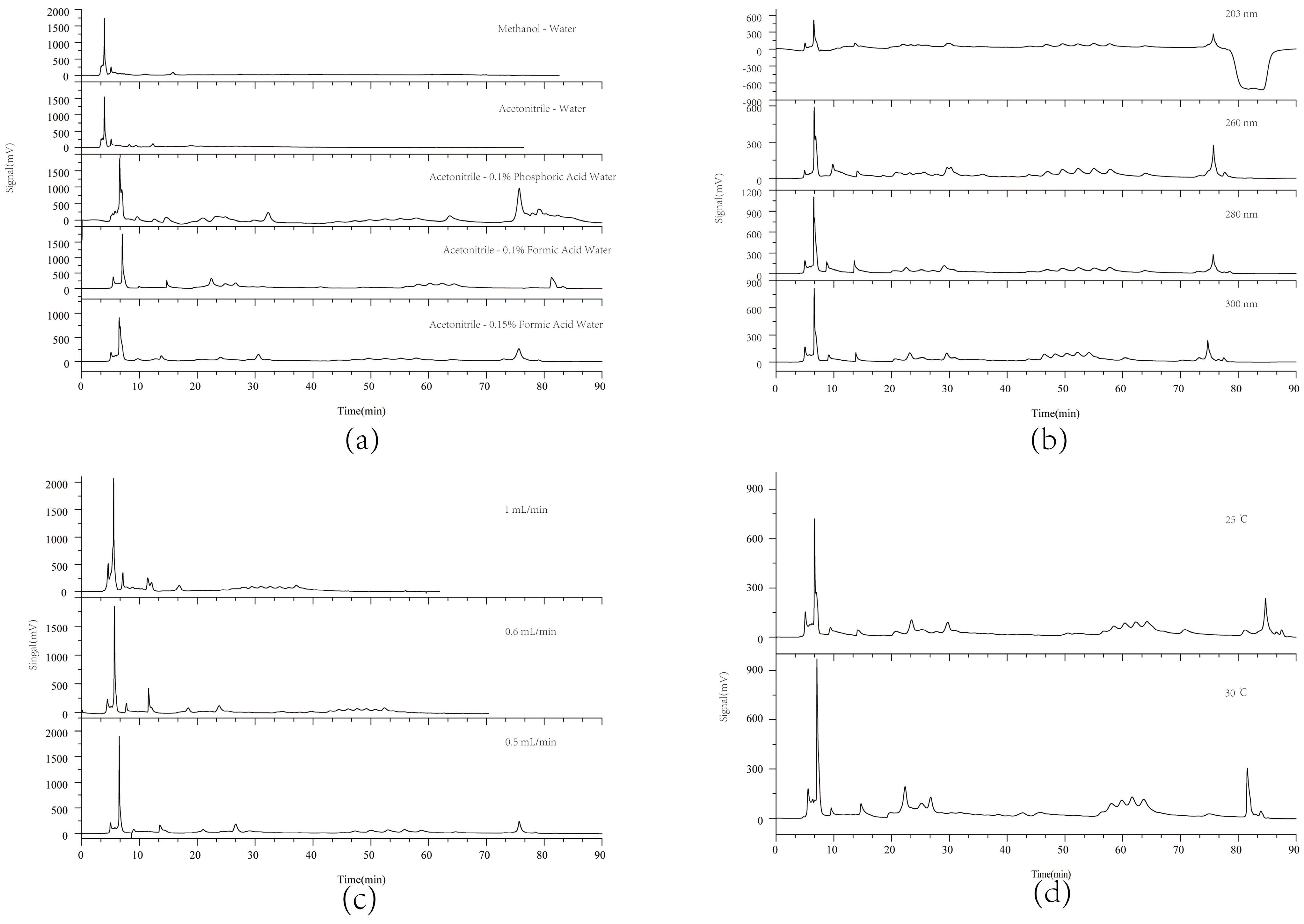
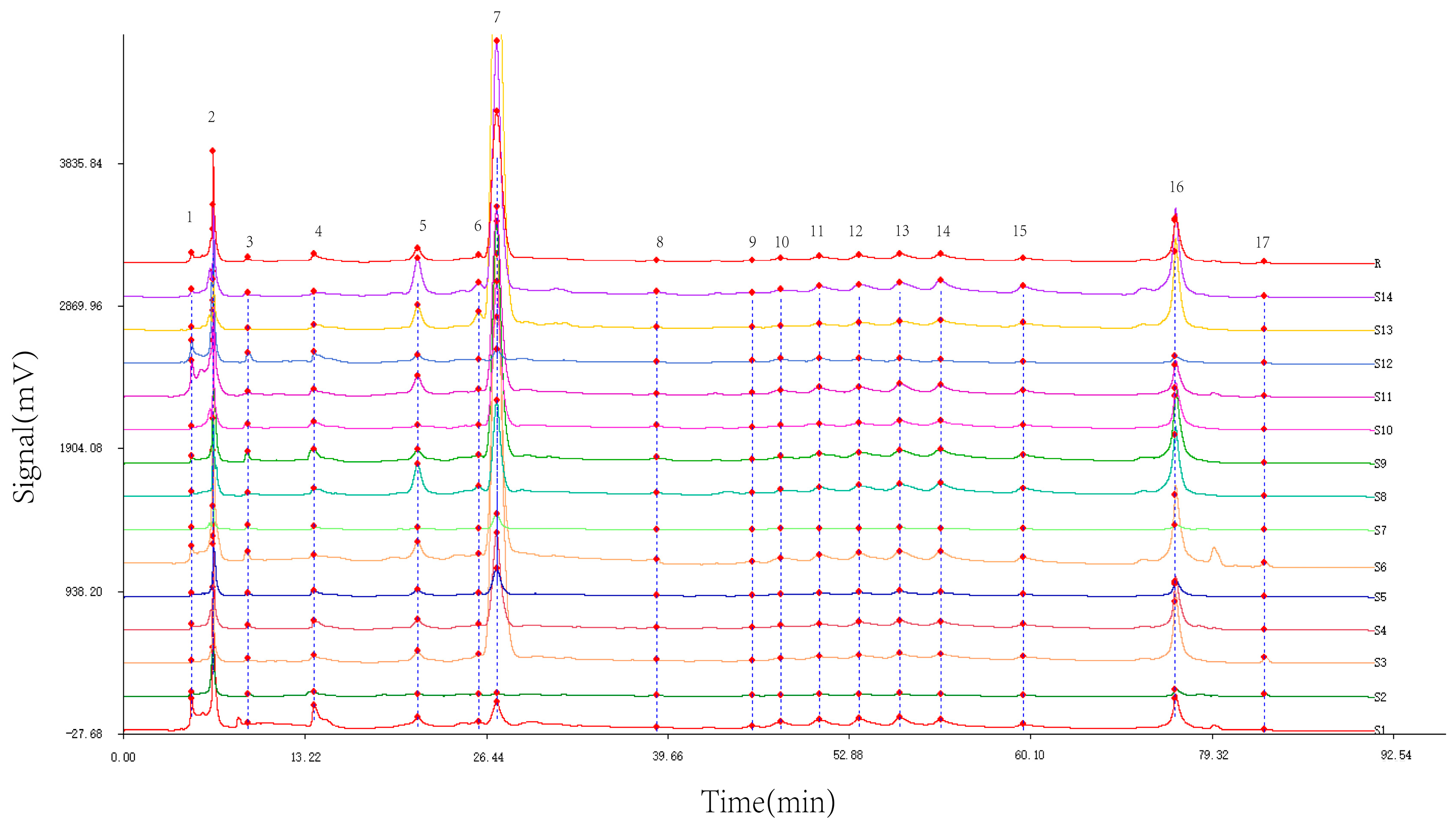
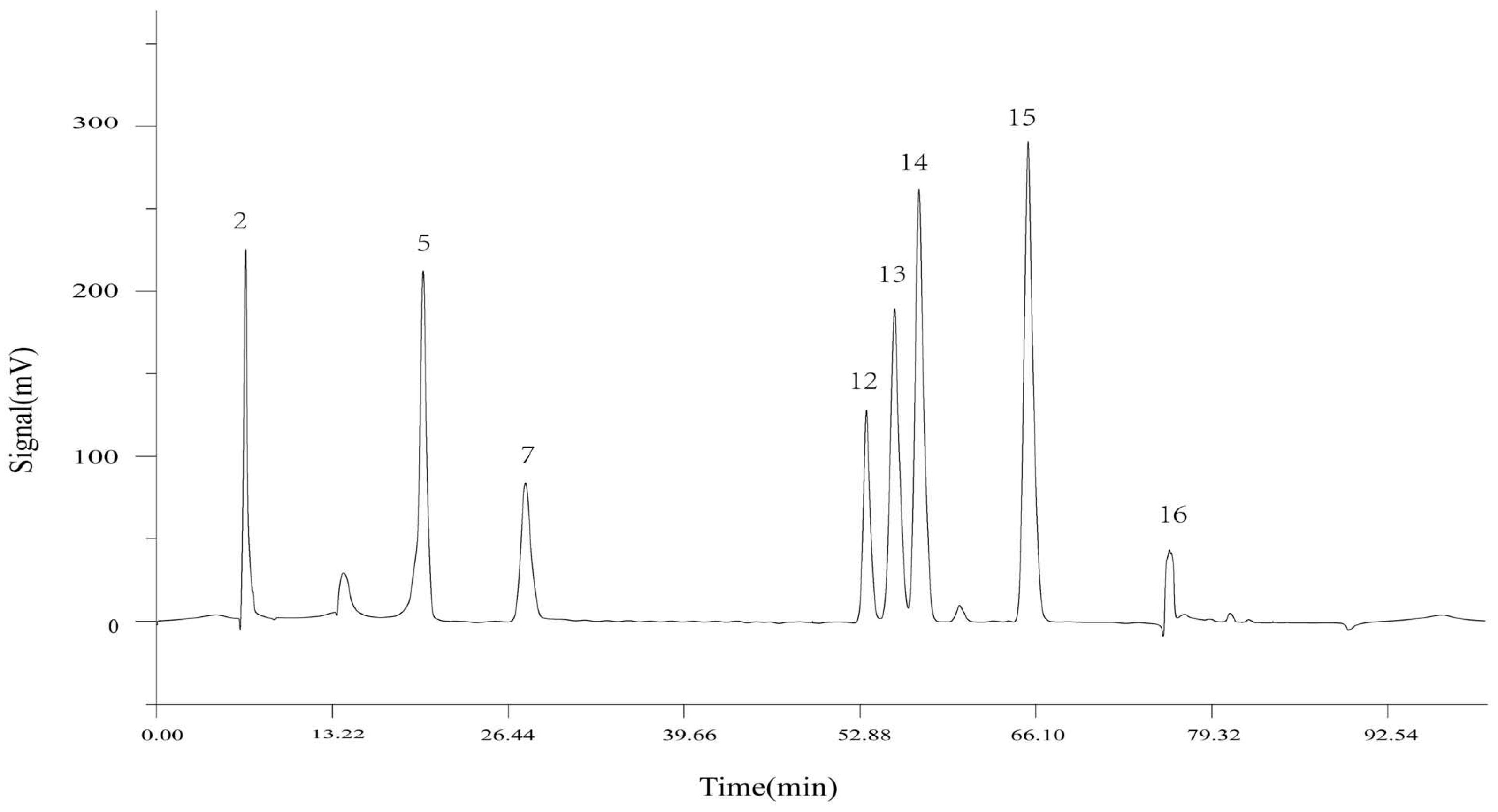
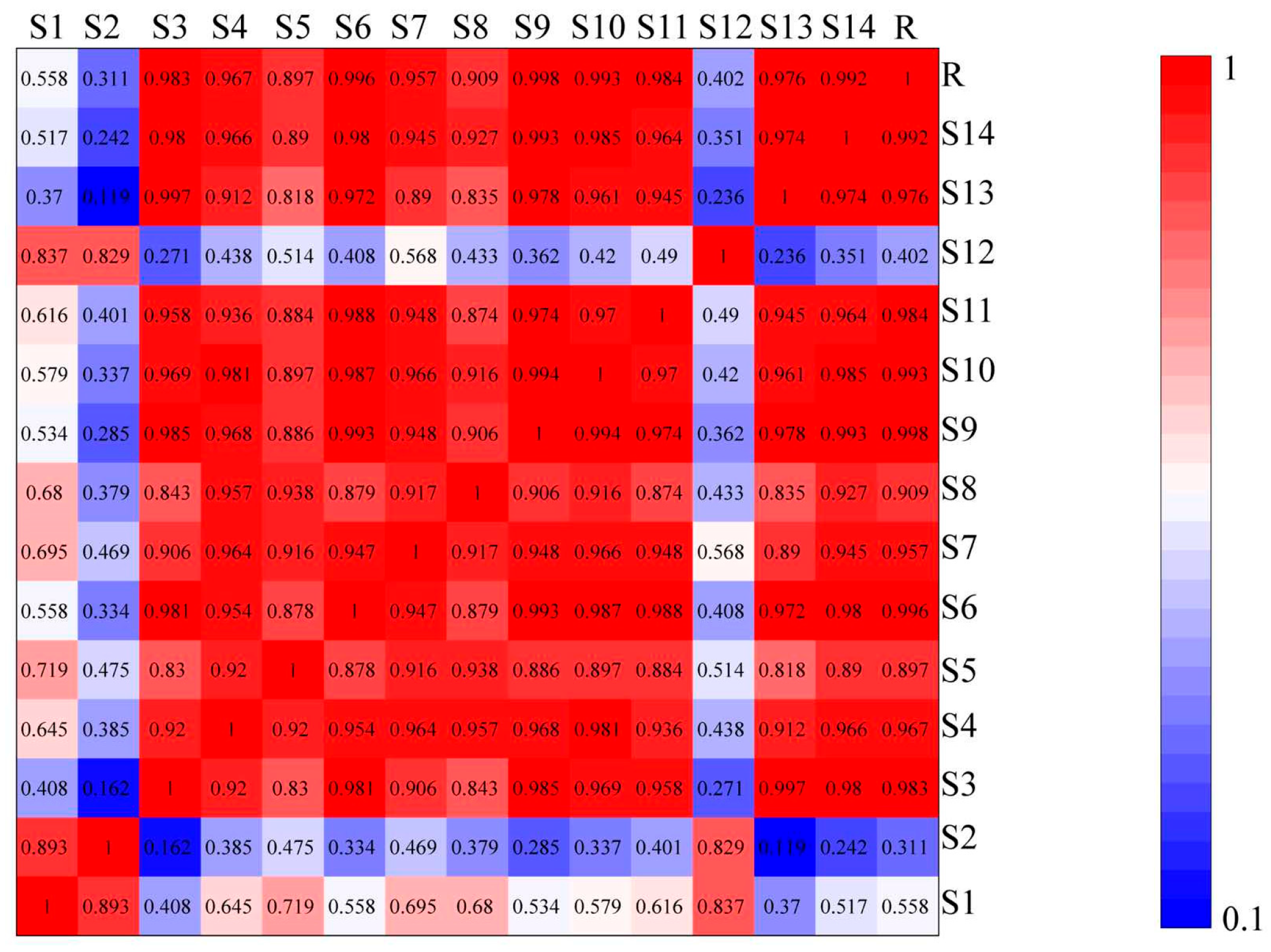
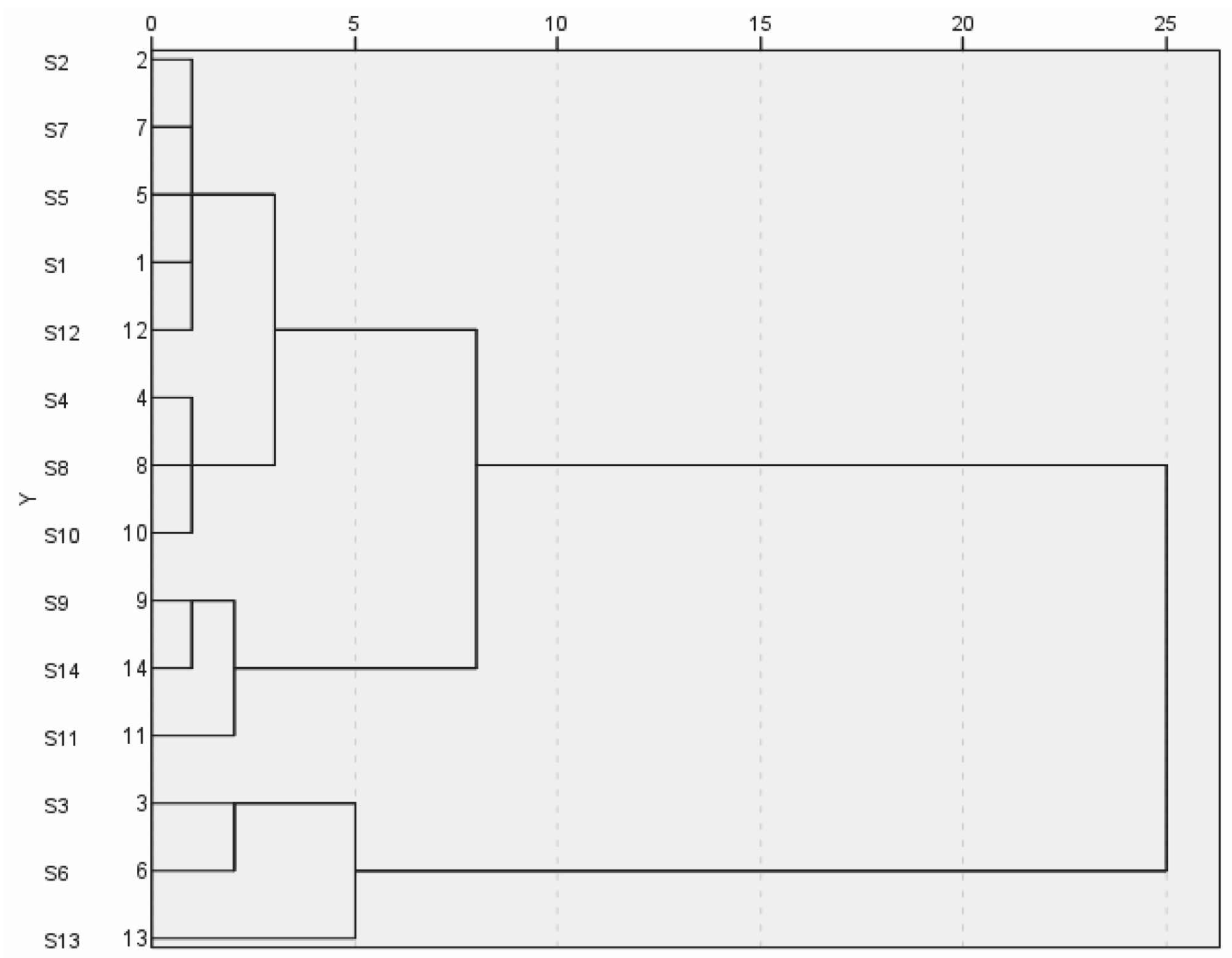
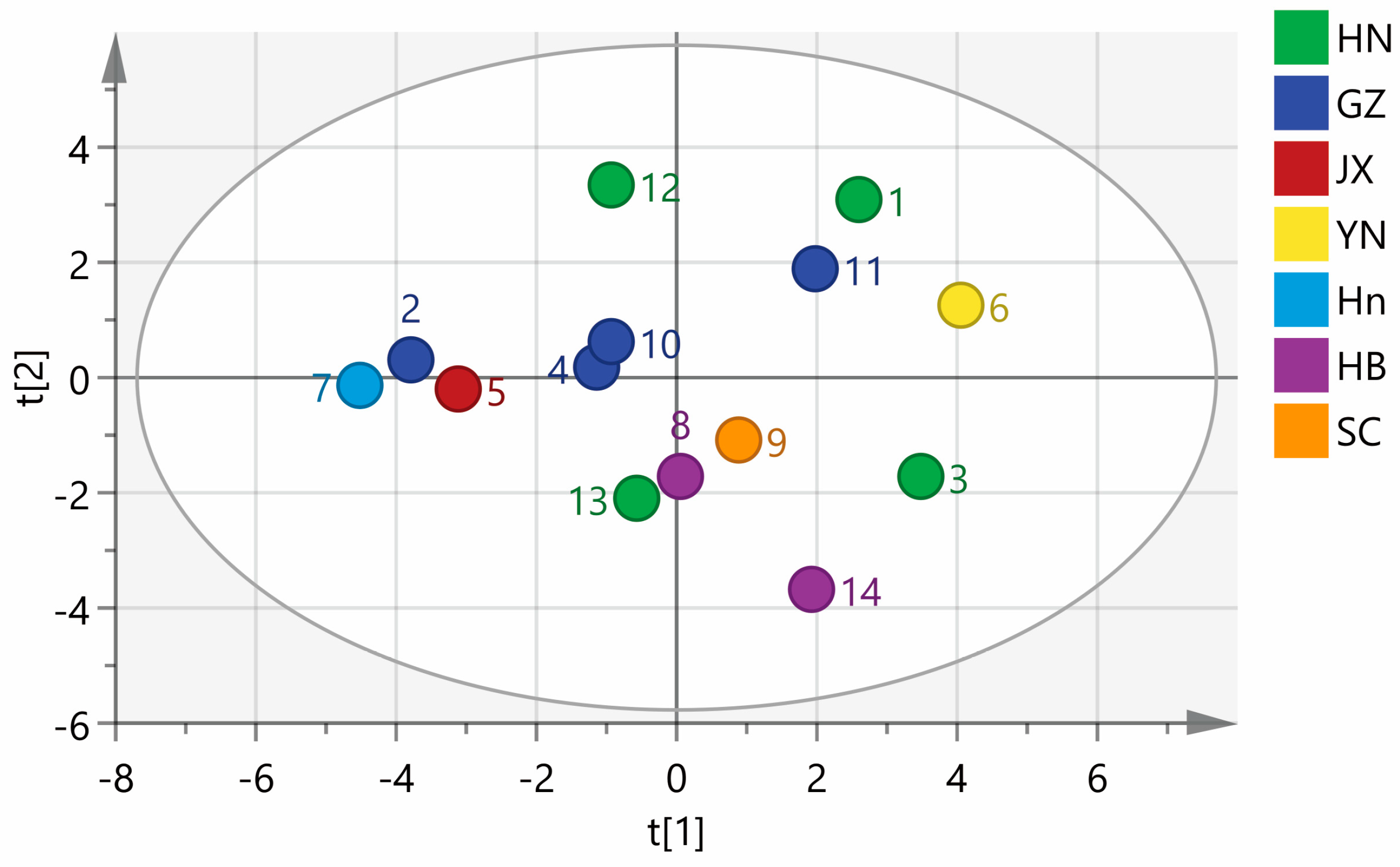
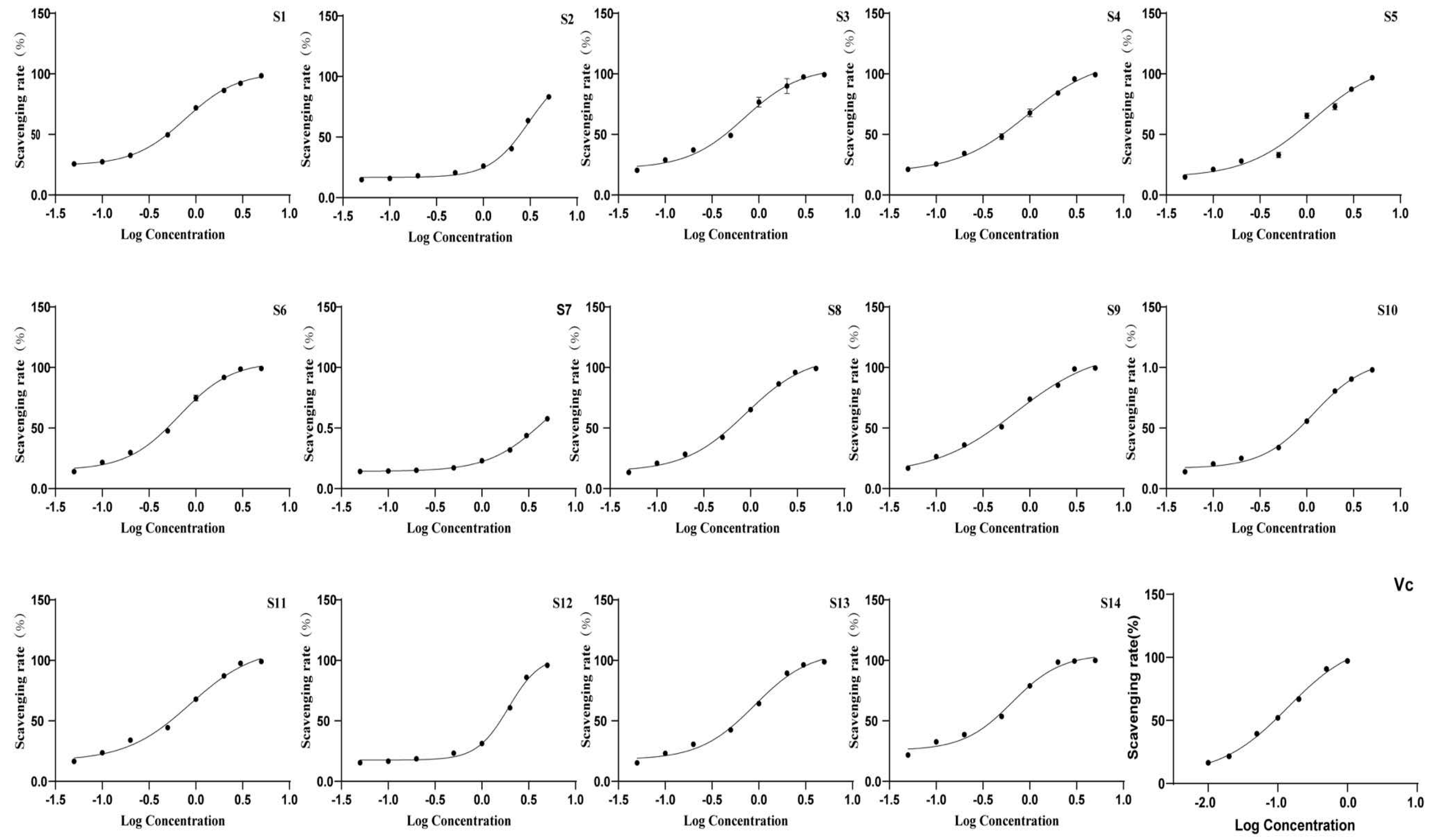
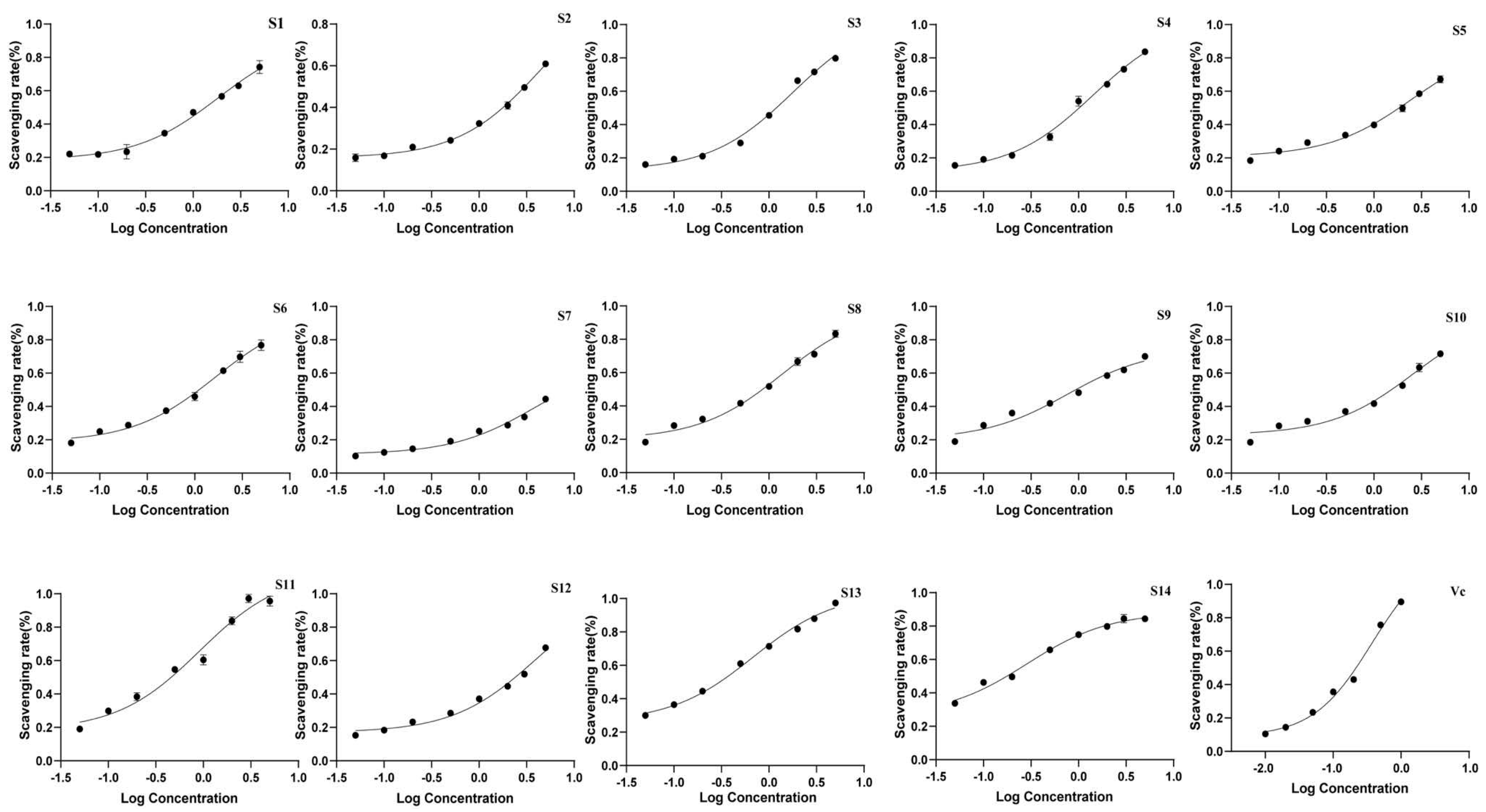
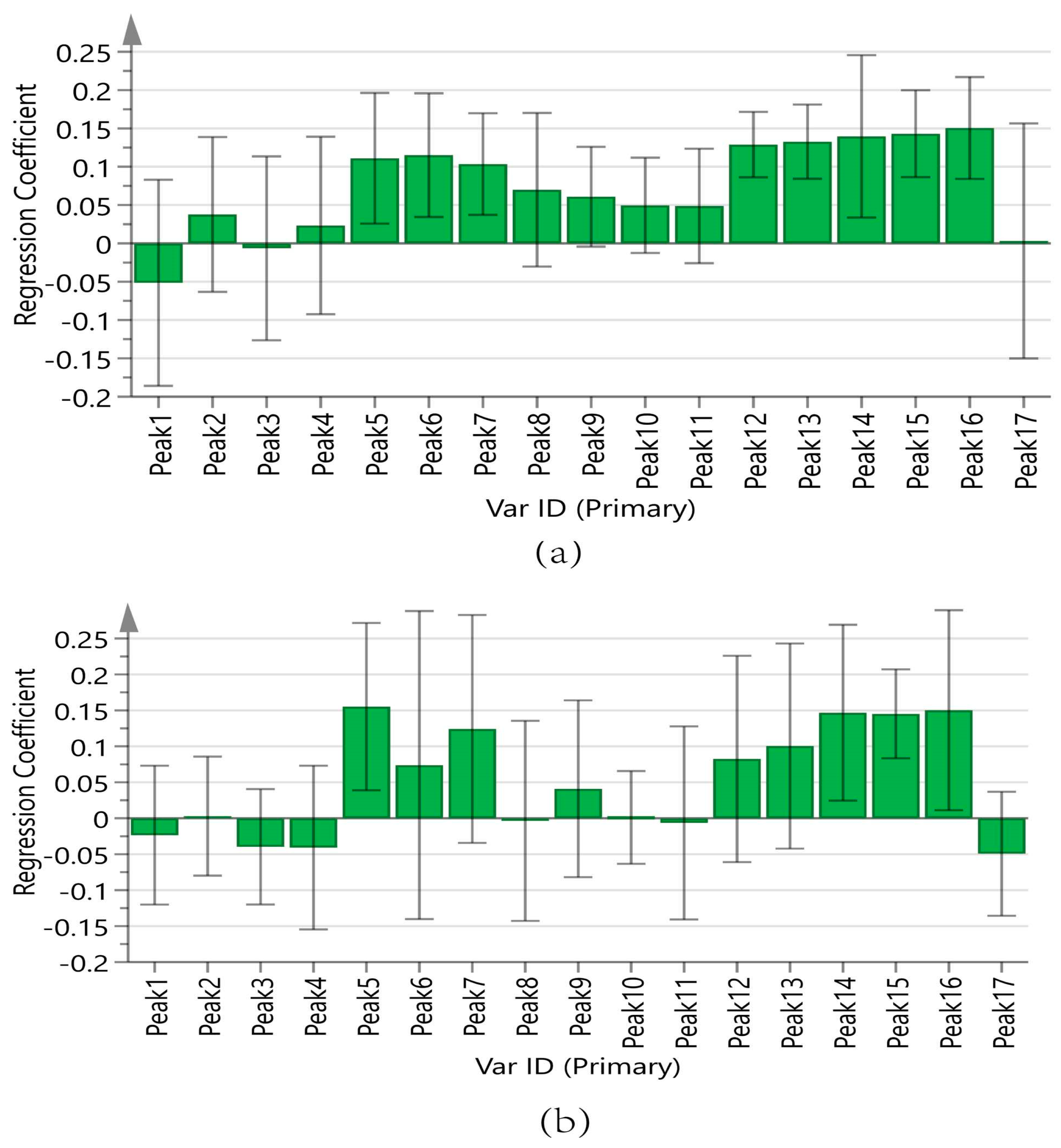
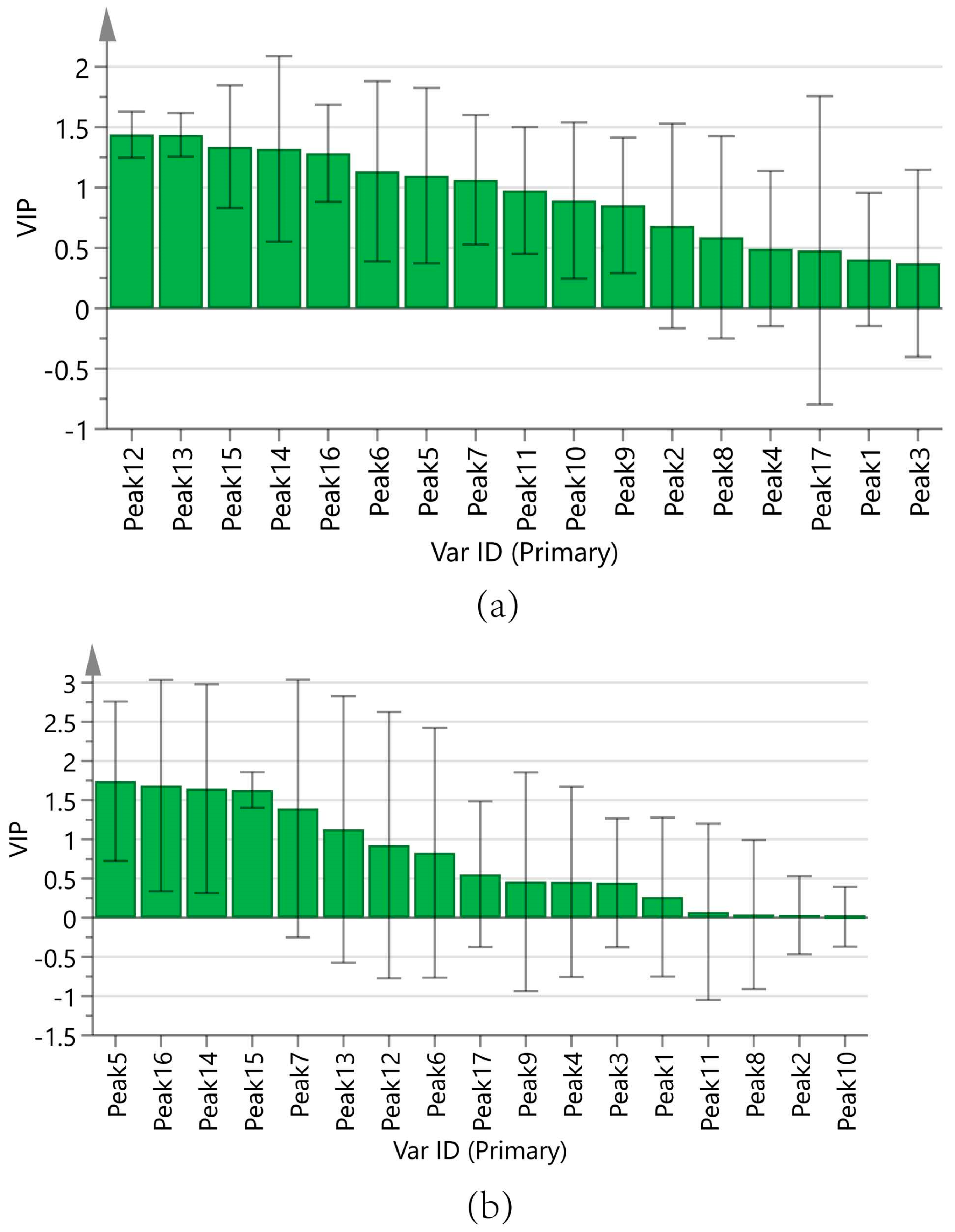
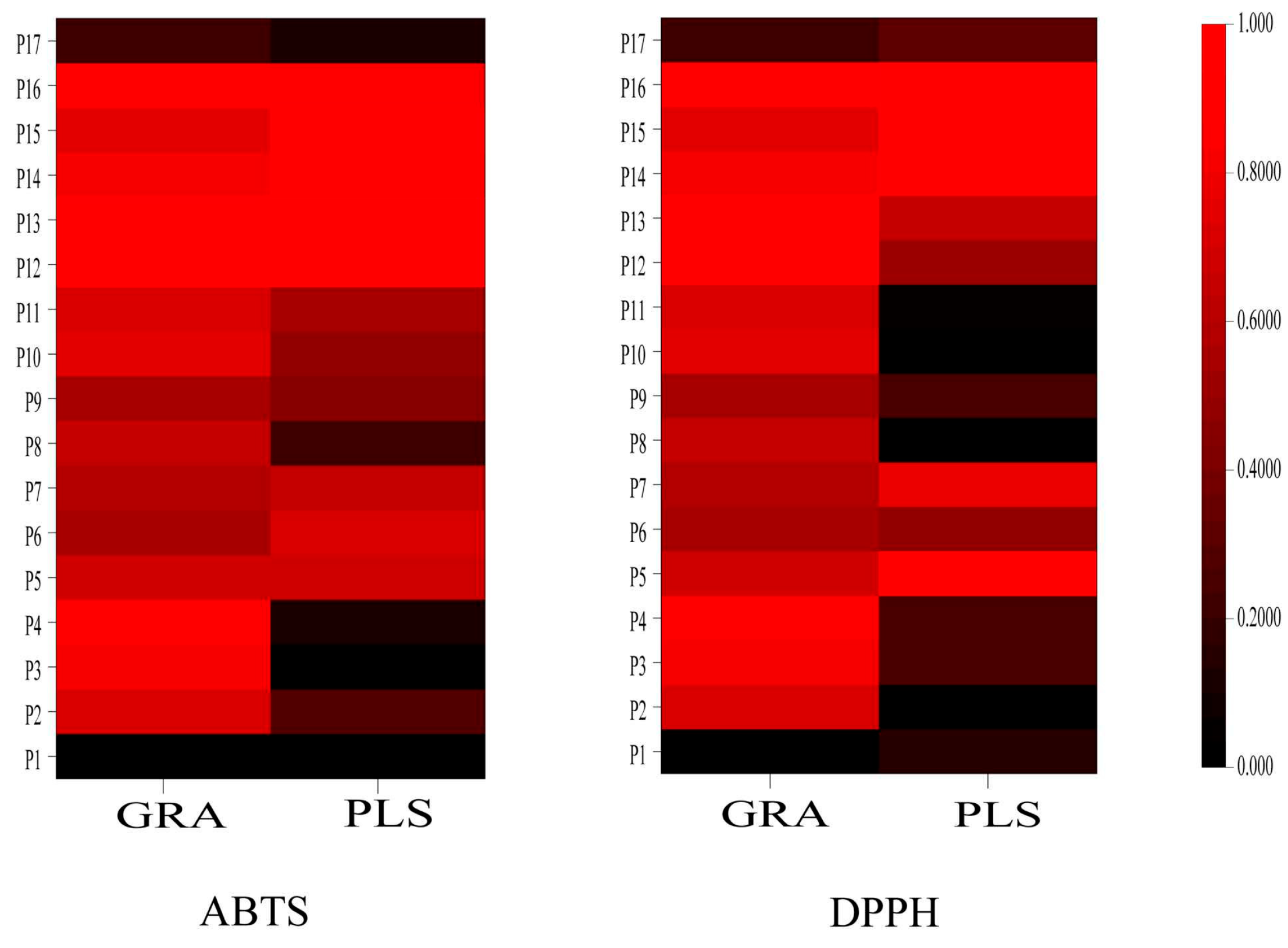
| No. | Origin | Batch No. | Manufacturer |
|---|---|---|---|
| S1 | Hunan | 2211002 | Jiangxi Zhongzhi Pharmaceutical Co., Ltd., Yichu, China |
| S2 | Guizhou | 220501 | Puning Zequn Traditional Chinese Medicine Decoction Pieces Co., Ltd., Puning, China |
| S3 | Hunan | 2303182 | Guangdong Qingyuan Traditional Chinese Medicine Decoction Pieces Co., Ltd., Maoming, China |
| S4 | Guizhou | 3230401 | Hebei Guosongtang Pharmaceutical Co., Ltd., Baoding, China |
| S5 | Jiangxi | 202310001 | Jiangxi Gufangyuan Decoction Pieces Co., Ltd., Zhangshu, China |
| S6 | Yunnan | 231101 | Henan Baode Decoction Pieces Technology Co., Ltd., Shangqiu, China |
| S7 | Henan | 20230402 | Guangdong Huiqun Decoction Pieces Co., Ltd., Shantou, China |
| S8 | Hebei | B23061302-06 | Hebei Chufeng Decoction Pieces Of Traditional Chinese Medicine Co., Ltd., Anguo, China |
| S9 | Sichuan | 230701 | Sichuan Qilong Decoction Pieces Co., Ltd., Chengdu, China |
| S10 | Guizhou | 230701 | Shaoyang Shennong Traditional Chinese Medicine Technology Development Co., Ltd., Shaoyang, China |
| S11 | Guizhou | 230801 | Guangdong Jingchang Traditional Chinese Medicine Decoction Pieces Co., Ltd., Huizhou, China |
| S12 | Hunan | 230601 | Bozhou Qingfeng Yutang Decoction Pieces Co., Ltd., Bozhou, China |
| S13 | Hunan | 231001 | Hunan Songlingtang Decoction Pieces Co., Ltd., Shaoyang, China |
| S14 | Hebei | 230501 | Hongya County Wawushan Pharmaceutical Co., Ltd., Meishan, China |
| Time (min) | A (%) | B (%) |
|---|---|---|
| 0 | 1 | 99 |
| 15 | 7 | 93 |
| 18 | 8 | 92 |
| 21 | 8 | 92 |
| 31 | 9 | 91 |
| 32 | 10 | 90 |
| 47 | 20 | 80 |
| 60 | 23 | 77 |
| 63 | 26 | 74 |
| 68 | 95 | 5 |
| 78 | 95 | 5 |
| 85 | 1 | 99 |
| 90 | 1 | 99 |
| Principal Component | Component Eigenvalue | Variance Contribution Rate (%) | Cumulative Variance Contribution Rate (%) |
|---|---|---|---|
| 1 | 7.034 | 41.379 | 41.379 |
| 2 | 3.954 | 23.261 | 64.641 |
| 3 | 1.639 | 9.640 | 74.280 |
| 4 | 1.397 | 8.217 | 82.498 |
| 5 | 1.309 | 7.702 | 90.200 |
| Common Peak | Principal Component 1 | Principal Component 2 | Principal Component 3 | Principal Component 4 | Principal Component 5 |
|---|---|---|---|---|---|
| P1 | 0.351 | 0.769 | −0.029 | 0.308 | −0.25 |
| P2 | 0.638 | 0.621 | 0.233 | 0.234 | 0.060 |
| P3 | 0.446 | 0.763 | 0.258 | 0.260 | 0.02 |
| P4 | 0.496 | 0.617 | −0.258 | 0.047 | 0.153 |
| P5 | 0.592 | −0.471 | −0.228 | 0.451 | −0.375 |
| P6 | 0.639 | −0.379 | −0.626 | −0.127 | 0.056 |
| P7 | 0.582 | −0.496 | 0.509 | −0.195 | −0.249 |
| P8 | 0.343 | 0.236 | 0.417 | −0.025 | 0.734 |
| P9 | 0.677 | 0.290 | 0.030 | −0.200 | −0.444 |
| P10 | 0.776 | 0.472 | 0.006 | −0.252 | −0.262 |
| P11 | 0.818 | 0.309 | −0.220 | −0.296 | −0.017 |
| P12 | 0.933 | −0.140 | −0.192 | −0.030 | 0.223 |
| P13 | 0.900 | −0.212 | −0.129 | 0.076 | 0.278 |
| P14 | 0.684 | −0.528 | −0.263 | 0.228 | 0.251 |
| P15 | 0.689 | −0.527 | 0.388 | 0.220 | 0.001 |
| P16 | 0.580 | −0.567 | 0.482 | 0.119 | −0.133 |
| P17 | 0.393 | −0.062 | 0.134 | −0.779 | 0.025 |
| No. | Batch | Principal Component 1 | Principal Component 2 | Principal Component 3 | Principal Component 4 | Principal Component 5 | Comprehensive Score |
|---|---|---|---|---|---|---|---|
| 1 | S6 | 1.235 | −0.249 | 1.381 | 0.818 | 1.560 | 0.853 |
| 2 | S1 | 1.691 | 0.737 | −1.039 | 0.383 | −0.459 | 0.476 |
| 3 | S3 | −0.579 | 1.343 | 0.014 | 2.778 | −0.612 | 0.471 |
| 4 | S11 | 1.504 | 0.141 | 0.110 | −0.462 | −0.614 | 0.392 |
| 5 | S14 | −0.879 | 2.000 | 0.709 | −1.171 | −0.558 | 0.225 |
| 6 | S9 | −0.378 | 0.610 | 0.502 | −0.827 | 1.692 | 0.219 |
| 7 | S8 | −0.374 | 0.797 | 0.240 | −1.138 | −0.738 | −0.059 |
| 8 | S10 | −0.270 | −0.276 | −0.318 | −0.198 | 1.783 | −0.075 |
| 9 | S12 | 1.447 | −0.705 | −0.904 | −0.666 | −0.646 | −0.098 |
| 10 | S13 | −0.283 | −1.649 | 2.364 | 0.142 | −1.345 | −0.120 |
| 11 | S4 | −0.327 | −0.371 | −0.261 | 0.225 | 0.443 | −0.182 |
| 12 | S5 | −0.824 | −0.387 | −0.907 | −0.104 | −0.334 | −0.590 |
| 13 | S2 | −0.937 | −1.015 | −0.981 | 0.508 | 0.192 | −0.680 |
| 14 | S7 | −1.026 | −0.976 | −0.910 | −0.287 | −0.365 | −0.833 |
| Sample | ABTS | DPPH | ||
|---|---|---|---|---|
| IC50 (mg/mL) | 95% CI IC50 (mg/mL) | IC50 (mg/mL) | 95% CI IC50 (mg/mL) | |
| S1 | 0.773 ± 0.011 d | 0.634~0.817 | 1.851 ± 0.026 j | 1.344~2.614 |
| S2 | 3.057 ± 0.020 a | 2.604~4.278 | 4.482 ± 0.013 a | 3.432~6.042 |
| S3 | 0.699 ± 0.038 de | 0.580~0.858 | 1.810 ± 0.035 j | 1.318~2.530 |
| S4 | 0.930 ± 0.023 f | 0.7974~1.149 | 1.808 ± 0.026 j | 1.129~2.816 |
| S5 | 1.182 ± 0.048 g | 0.845~2.424 | 2.476 ± 0.024 b | 1.637~3.903 |
| S6 | 0.662 ± 0.025 e | 0.598~0.732 | 1.647 ± 0.024 c | 1.240~2.214 |
| S7 | 4.592 ± 0.007 b | 3.558~7.148 | 3.890 ± 0.018 k | 2.278~6.537 |
| S8 | 0.887 ± 0.0 22 f | 0.793~1.012 | 1.381 ± 0.028 d | 0.997~1.940 |
| S9 | 0.712 ± 0.028 dge | 0.583~0.926 | 0.770 ± 0.044 e | 0.366~1.618 |
| S10 | 1.181 ± 0.022 g | 1.063~1.350 | 2.621 ± 0.032 f | 1.558~4.723 |
| S11 | 0.871 ± 0.031 f | 0.740~1.082 | 0.914 ± 0.049 g | 0.606~1.379 |
| S12 | 1.929 ± 0.022 c | 1.807~2.081 | 3.935 ± 0.024 k | 2.502~6.748 |
| S13 | 0.899 ± 0.030 f | 0.787~1.060 | 0.656 ± 0.020 h | 0.556~0.839 |
| S14 | 0.649 ± 0.035 e | 0.557~0.748 | 0.509 ± 0.022 i | 0.406~0.611 |
| Positive control | 0.139 ± 0.019 | 0.117~0.156 | 0.373 ± 0.028 | 0.290~0.487 |
| Peaks | ABST | DPPH | ||
|---|---|---|---|---|
| Correlations | Rank | Correlations | Rank | |
| P1 | 0.6377 | 17 | 0.6506 | 17 |
| P2 | 0.8070 | 8 | 0.7903 | 9 |
| P3 | 0.8373 | 9 | 0.7832 | 12 |
| P4 | 0.8427 | 1 | 0.7891 | 10 |
| P5 | 0.8001 | 2 | 0.8401 | 2 |
| P6 | 0.7709 | 6 | 0.8004 | 8 |
| P7 | 0.7740 | 7 | 0.7847 | 11 |
| P8 | 0.7948 | 3 | 0.8120 | 7 |
| P9 | 0.7721 | 16 | 0.7787 | 15 |
| P10 | 0.8159 | 10 | 0.7802 | 14 |
| P11 | 0.8124 | 5 | 0.7805 | 13 |
| P12 | 0.8776 | 4 | 0.8201 | 6 |
| P13 | 0.8643 | 11 | 0.8323 | 3 |
| P14 | 0.8363 | 15 | 0.8494 | 1 |
| P15 | 0.8213 | 13 | 0.8276 | 5 |
| P16 | 0.8475 | 12 | 0.8296 | 4 |
| P17 | 0.6906 | 14 | 0.6797 | 16 |
Disclaimer/Publisher’s Note: The statements, opinions and data contained in all publications are solely those of the individual author(s) and contributor(s) and not of MDPI and/or the editor(s). MDPI and/or the editor(s) disclaim responsibility for any injury to people or property resulting from any ideas, methods, instructions or products referred to in the content. |
© 2025 by the authors. Licensee MDPI, Basel, Switzerland. This article is an open access article distributed under the terms and conditions of the Creative Commons Attribution (CC BY) license (https://creativecommons.org/licenses/by/4.0/).
Share and Cite
Zhang, L.-W.; Wang, J.; Ge, Y.; Kuang, Z.-L.; Zhang, Y.-Q. HPLC Fingerprint Analysis with the Antioxidant Potential of Polygonatum sibiricum Combined with the Chemometric Calculations. Separations 2025, 12, 81. https://doi.org/10.3390/separations12040081
Zhang L-W, Wang J, Ge Y, Kuang Z-L, Zhang Y-Q. HPLC Fingerprint Analysis with the Antioxidant Potential of Polygonatum sibiricum Combined with the Chemometric Calculations. Separations. 2025; 12(4):81. https://doi.org/10.3390/separations12040081
Chicago/Turabian StyleZhang, Li-Wen, Jin Wang, Ye Ge, Zhe-Lin Kuang, and Ying-Qing Zhang. 2025. "HPLC Fingerprint Analysis with the Antioxidant Potential of Polygonatum sibiricum Combined with the Chemometric Calculations" Separations 12, no. 4: 81. https://doi.org/10.3390/separations12040081
APA StyleZhang, L.-W., Wang, J., Ge, Y., Kuang, Z.-L., & Zhang, Y.-Q. (2025). HPLC Fingerprint Analysis with the Antioxidant Potential of Polygonatum sibiricum Combined with the Chemometric Calculations. Separations, 12(4), 81. https://doi.org/10.3390/separations12040081






